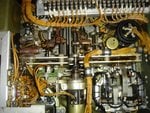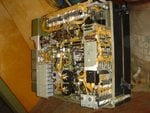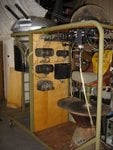syscom3
Pacific Historian
I started this thread to discuss anything about the B29 and the B50, good or bad. I invite anyone to add to it, just try to stay on topic.
My first post is from the B29 website. Its about the ballistics and aiming computer the B29 used.
The author of this gave me permission to copy it here.
Taigh Ramey
Proprietor, Vintage Aircraft
7432 C.E.Dixon Street
Stockton, California 95206
(209) 982-0273
www.twinbeech.com
Here are some more shots of the other side of the computer. On this side you can see the selsyn generators which are also in the turret and the sighting station (black cylinders with 5 wires attached). Please correct me if I am wrong, as I am eager to learn as much as possible about this system, but here is my simplistic explanation of how the system works:
There are two selsyns for determining azimuth and two for elevation. Two selsyns are mounted on and are geared to rotate with the turret and two are mounted on and are geared to rotate with the sight. These two selsyns (each rotates at a different speed) determine the position of the sight and the turret. If there is a difference between the position of the sight and the turret a voltage is created and the amplifier senses the voltage. The amplifier (square box in the DSC00436 photo) then applies a voltage to the field of Amplidyne (one of the two large motor generators on the DSC00436 photo) which puts out the voltage to drive the turret motor . There are two motors in each turret, one to drive it in azimuth and one for elevation. There is one Amplidyne for azimuth and one for elevation or a set of two for each turret. When the turret comes into alignment with the sight the differential voltage generated by the selsyns goes to zero and the amplifier reduces the field voltage to the amplidyne and thus the power to the turret drive motor is also reduced to zero.
The computer can be put in the system to make corrections to compensate for certain parameters like temperature, altitude, airspeed, range and the acceleration of the attacking plane (on later RCT systems). Barometric altitude, indicated airspeed and outside air temperature were entered into the system via the Navigators hand set, photos of which will follow in the next e-mail. The higher the altitude the thinner the air and the less resistance the bullet will have on its trajectory. The higher the airspeed the more the guns will have to be deflected upwind for the bullets to hit the target, assuming a broadside attack. The lower the temperature the higher the air density which also affects the path of the bullet. Later systems had two gyros mounted on the sighting stations which would sense the acceleration of the fighter by the sensing how fast the gunner was turning the sight while tracking the target. The computer would also take this into account to adjust the guns to hit the target.
The idea was for the gunner to keep a ring of dots centered on the target. The ring of dots was adjustable with the right hand wheel of the pedestal sight and the right grip on the upper ring sight. The gunner would turn a small knob just below the sight to the size of the wingspan of the attacking fighter. If it was a Japanese Zero then he would turn the knob until 36 (the wingspan in feet) was the number visible in the bottom of the sight glass. Then the gunner would adjust the ring of dots to the wingspan of the fighter as seen through the sight glass. This would give the computer basic range information. If the fighter was further out the guns would have to be elevated for the bullets to hit the target. If the computer was selected into the system the gunner would keep the sight centered on the target and keep the ring of dots adjusted to the wingspan while tracking on the target. He would thumb one of the triggers (on each side of the pedestal sight and a pull trigger on the ring sight) to fire the guns. The computer would compute the lead, elevation, range and parallax and would adjust the position of the turret and guns by deflecting them so the bullets would hit the target. The parallax was the difference in distance between the sighting station and the turret. The computer would adjust the guns so the bullets would converge to hit the target to compensate for this parallax. There were double parallax computers as well which would allow one gunner to use two turrets to shoot at a target. The double parallax computer would adjust the guns so that the bullets from both turrets would converge at the target.
With the computer switched out of the system (this switch is on the sighting station) the turret will simply point in direct alignment with the sight. In this mode the gunner would put in his own lead and elevation by deflecting the sight manually. The range, acceleration, altitude, airspeed and temperature information was not used in this manual mode and the gunner would use his experience to get the bullets on target. In this mode the parallax and double parallax was not computed so the bullets of both turrets would follow a parallel path.
I find it interesting that the four computers mounted under the floorboards in the radar compartment had lots of armor plate around them for protection. The computer for the bombardier's system was mounted in front of the Navigator or just behind the armor plate of the pilot.
Incidentally there were computing sight in turrets going into WWII. The B-17 and B-24 has computing sights in their upper and ball turrets. The K-3 sight was used in the upper turret of the B-17 and the K-4 was used in the lower ball turret. These sights were similar in their computations or range and deflection but they didn't take temperature and acceleration into account. These sights didn't use selsyns for position nor did they need to calculate parallax as they were mounted inside the turret in front of the gunner. He would manually input wingspan and range information and the sight would adjust the gun sight. The gunner would keep the sight on the target and adjust the range, typically with a range foot pedal. The sight was connected with flexible shafts to the azimuth and elevation gear boxes to receive position information. They even came out with compensating sights for the single waste guns in the B-17, B-24 and the B-25. These sights were also connected to the gun mount with flexible shafts to give them azimuth and elevation inputs.
I have found information documenting the use of video guided bombs being developed in WWII as well as the more common radio guided bombs. Everyone seemed to be fascinated to see the video from the nose of bombs hitting buildings in Iraq in Desert Storm. I enjoy the fact that they were doing that in WWII! I like to learn about the development of technology in WWII. From iron ring sights on 30 cal hand held guns to computers, radar and video guided ordnance in a few short years is amazing to me. I know that these systems were not in wide use in WWII but the B-29 is a great example of this technology. Remote turrets allowing the gunner to be out of the wind and in a more comfortable heated and pressurized environment so he could do his job better is pretty high tech considering what was used in 1941.
My first post is from the B29 website. Its about the ballistics and aiming computer the B29 used.
The author of this gave me permission to copy it here.
Taigh Ramey
Proprietor, Vintage Aircraft
7432 C.E.Dixon Street
Stockton, California 95206
(209) 982-0273
www.twinbeech.com
Here are some more shots of the other side of the computer. On this side you can see the selsyn generators which are also in the turret and the sighting station (black cylinders with 5 wires attached). Please correct me if I am wrong, as I am eager to learn as much as possible about this system, but here is my simplistic explanation of how the system works:
There are two selsyns for determining azimuth and two for elevation. Two selsyns are mounted on and are geared to rotate with the turret and two are mounted on and are geared to rotate with the sight. These two selsyns (each rotates at a different speed) determine the position of the sight and the turret. If there is a difference between the position of the sight and the turret a voltage is created and the amplifier senses the voltage. The amplifier (square box in the DSC00436 photo) then applies a voltage to the field of Amplidyne (one of the two large motor generators on the DSC00436 photo) which puts out the voltage to drive the turret motor . There are two motors in each turret, one to drive it in azimuth and one for elevation. There is one Amplidyne for azimuth and one for elevation or a set of two for each turret. When the turret comes into alignment with the sight the differential voltage generated by the selsyns goes to zero and the amplifier reduces the field voltage to the amplidyne and thus the power to the turret drive motor is also reduced to zero.
The computer can be put in the system to make corrections to compensate for certain parameters like temperature, altitude, airspeed, range and the acceleration of the attacking plane (on later RCT systems). Barometric altitude, indicated airspeed and outside air temperature were entered into the system via the Navigators hand set, photos of which will follow in the next e-mail. The higher the altitude the thinner the air and the less resistance the bullet will have on its trajectory. The higher the airspeed the more the guns will have to be deflected upwind for the bullets to hit the target, assuming a broadside attack. The lower the temperature the higher the air density which also affects the path of the bullet. Later systems had two gyros mounted on the sighting stations which would sense the acceleration of the fighter by the sensing how fast the gunner was turning the sight while tracking the target. The computer would also take this into account to adjust the guns to hit the target.
The idea was for the gunner to keep a ring of dots centered on the target. The ring of dots was adjustable with the right hand wheel of the pedestal sight and the right grip on the upper ring sight. The gunner would turn a small knob just below the sight to the size of the wingspan of the attacking fighter. If it was a Japanese Zero then he would turn the knob until 36 (the wingspan in feet) was the number visible in the bottom of the sight glass. Then the gunner would adjust the ring of dots to the wingspan of the fighter as seen through the sight glass. This would give the computer basic range information. If the fighter was further out the guns would have to be elevated for the bullets to hit the target. If the computer was selected into the system the gunner would keep the sight centered on the target and keep the ring of dots adjusted to the wingspan while tracking on the target. He would thumb one of the triggers (on each side of the pedestal sight and a pull trigger on the ring sight) to fire the guns. The computer would compute the lead, elevation, range and parallax and would adjust the position of the turret and guns by deflecting them so the bullets would hit the target. The parallax was the difference in distance between the sighting station and the turret. The computer would adjust the guns so the bullets would converge to hit the target to compensate for this parallax. There were double parallax computers as well which would allow one gunner to use two turrets to shoot at a target. The double parallax computer would adjust the guns so that the bullets from both turrets would converge at the target.
With the computer switched out of the system (this switch is on the sighting station) the turret will simply point in direct alignment with the sight. In this mode the gunner would put in his own lead and elevation by deflecting the sight manually. The range, acceleration, altitude, airspeed and temperature information was not used in this manual mode and the gunner would use his experience to get the bullets on target. In this mode the parallax and double parallax was not computed so the bullets of both turrets would follow a parallel path.
I find it interesting that the four computers mounted under the floorboards in the radar compartment had lots of armor plate around them for protection. The computer for the bombardier's system was mounted in front of the Navigator or just behind the armor plate of the pilot.
Incidentally there were computing sight in turrets going into WWII. The B-17 and B-24 has computing sights in their upper and ball turrets. The K-3 sight was used in the upper turret of the B-17 and the K-4 was used in the lower ball turret. These sights were similar in their computations or range and deflection but they didn't take temperature and acceleration into account. These sights didn't use selsyns for position nor did they need to calculate parallax as they were mounted inside the turret in front of the gunner. He would manually input wingspan and range information and the sight would adjust the gun sight. The gunner would keep the sight on the target and adjust the range, typically with a range foot pedal. The sight was connected with flexible shafts to the azimuth and elevation gear boxes to receive position information. They even came out with compensating sights for the single waste guns in the B-17, B-24 and the B-25. These sights were also connected to the gun mount with flexible shafts to give them azimuth and elevation inputs.
I have found information documenting the use of video guided bombs being developed in WWII as well as the more common radio guided bombs. Everyone seemed to be fascinated to see the video from the nose of bombs hitting buildings in Iraq in Desert Storm. I enjoy the fact that they were doing that in WWII! I like to learn about the development of technology in WWII. From iron ring sights on 30 cal hand held guns to computers, radar and video guided ordnance in a few short years is amazing to me. I know that these systems were not in wide use in WWII but the B-29 is a great example of this technology. Remote turrets allowing the gunner to be out of the wind and in a more comfortable heated and pressurized environment so he could do his job better is pretty high tech considering what was used in 1941.



